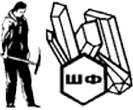Добрый день, Коллеги. Важное сообщение, просьба принять участие. Музей Ферсмана ищет помощь для реставрационных работ в помещении. Подробности по ссылке
The Porphyry Au-Cu Deposits and Related Shoshonitic Magmatism of the Palaeozoic Macquarie Volcanic Arc, Eastern Lachlan Orogen in New South Wales, Australia: A Review
Ordovician volcanic, volcaniclastic and intrusive rocks of calc-alkaline affinity in the Eastern Subprovince of the Lachlan Orogen were formed in the intraoceanic Macquarie Volcanic Arc. The Macquarie Arc was developed in response to west-dipping subduction along part of the boundary between eastern Gondwana and the proto-Pacific Plate and was situated on the Gondwana Plate, some 1000 km east of Precambrian continental crust. The intervening area was occupied by a back arc basin that developed on oceanic crust as the proto-PacificPlate rolled back eastwards after the Middle Cambrian Delamerian Orogeny. Subsequent extension, strike-slip translation and thin-skinned tectonics have structurally dissected the single arc into four north to NNE trending structural belts of Ordovician calc-alkaline rocks that are separated largely by younger rift basins and in part by coeval craton-derived turbidites.
Two of the belts host substantial porphyry style gold-copper, and epithermal gold deposits. The currently exploited porphyry gold-copper deposits are localised in two tight clusters in the Cadia and Goonumbla districts, which are approximately 100 kilometres apart, and fall within a major, long-lived, NW- to WNW-trending, semi-continental scale, structural corridor known as the Lachlan Transverse Zone.
The Cadia district comprises four porphyry style deposits, Ridgeway, Cadia Hill, Cadia Quarry and Cadia East, which have a combined resource of 1210 Mt @ 0.75 g/t Au, 0.32% Cu with a total of 905 tonnes (29 Moz) of contained gold. These ore deposits are spatially associated with Late Ordovician to Early Silurian, shoshonitic, porphyritic monzonite to quartz-monzonite phases of the Cadia Igneous Complex (CIC), intruding Late Ordovician coarse volcaniclastic rocks of similar composition to the CIC. The intrusive complex is represented as a stock at Cadia Hill and Cadia Quarry, a narrow restricted pipe at Ridgeway and as a series of dykes at Cadia East. The ore deposits occur as a string of mineralised centres within, and elongated parallel to, a 7 km long, NW- to WNW-trending corridor of alteration and mineralisation that is up to 2 km in width and has been intersected by drilling to a depth of more than 1600 m. Mineralisation occurs as sheeted quartz-sulphide veins at Cadia Hill, Cadia Quarry and Cadia East, as stockwork quartz veins at Ridgeway and Cadia Quarry and as disseminations at Cadia East, and, depending on the deposit, is hosted by either the CIC intrusive rocks alone, or by both the intrusive and volcaniclastic wallrocks. Veins are mainly quartz-calcite with bornite, grading outwards to chalcopyrite and pyrite. Alteration takes the form of an early sodic phase, overprinted by potassic alteration and pervasive propylitisation. Individual veins have selvages of potassic and calc-potassic alteration. Skarn bodies are found in adjacent carbonate bearing units, while phyllic alteration is generally restricted to late stage faults.
The Goonumbla district includes four economic deposits, Endeavour 22, 26, 27 and 48, hosted by Early Silurian shoshonitic intrusive and Late Ordovician volcaniclastic rocks of the Goonumbla Igneous Complex and lie within a 22 km diameter circular structure that embraces a series of mineralised centres. The four deposits had a combined pre-mining resource of 132 Mt @ 1.1% Cu, 0.5 g/t Au. Each is centred on a separate, narrow, pipe-like, vertical, quartz monzonite porphyry complex comprising up to nine intrusive phases. These intrusive complexes have lateral dimensions in the order of 50 to 150 m and minimum vertical extents of 600 to 900 m. The associated ore zones are up to 400 m in diameter at a 0.5% Cu equivalent cutoff. Main stage mineralisation at all four deposits is associated with the same K feldspar quartz monzonite porphyry and augite-K feldspar quartz monzonite porphyry intrusive phases and is characterised by multiple generations of stockwork and sheeted quartz, K feldspar, bornite, chalcopyrite and gold-bearing veins. Early Stage pervasive biotite-magnetite and propylitic alteration is overprinted by Main Stage mineralised veins that have halos of early K feldspar and later sericite-hematite. Sulphides are zoned from proximal bornite, through bornite and chalcopyrite, to chalcopyrite and peripheral pyrite.




